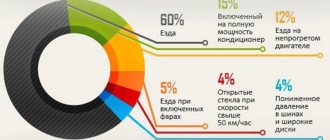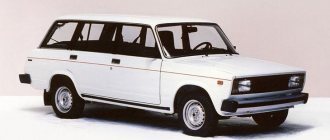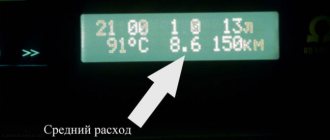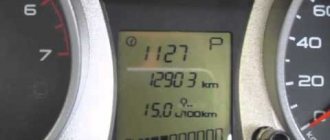VAZ 2107 fuel consumption per 100 km carburetor
To talk about whether a car consumes a lot of gasoline, you need to know what the consumption should actually be.
Depending on the engine installed on the car, the consumption may be as follows (for more details on the consumption of carburetor cars, see our fuel consumption table for carburetor cars):
| Engine | Consumption per 100 km |
| VAZ 2102, 2103 (1.5, Carburetor) | Average 10.5 / city 11.5 / highway 7.2 |
| 2106 (1.57 engine, carburetor, four-speed gearbox) | Average 9.5 / city 10.5 / highway 8.5 |
| 2106 (1.45 engine, carburetor, four-speed gearbox) | Average 9.9 / city 10.8 / highway 9.0 |
| 2107 (1.6, carburetor) | Average 8.9 / city 10.2 / highway 7.5 |
| 2107 (1.5, carburetor) | Average 8.3 / city 9.6 / highway 7 |
The difference is obvious. However, the power of the first engine is 72 hp. , and the second one is 80. That’s why it consumes so much gasoline. However, in the case when there is an increase in consumption above the nominal, it is worth talking about too much fuel consumption.
Is it possible to reduce fuel consumption yourself?
- In the main, that is, in the first metering chamber of the carburetor, you need to increase the size of the air nozzle. Professionals in their field talk about this process in detail in a training video that you can watch at a time convenient for you.
- Next you need to adjust the idle speed. For this operation you will need a special screw, which is called a “tuning” screw, with its help you need to check the operation of the engine in idle gear. If no so-called dips are observed when idling, the screw is simply screwed back in and the adjustment can be considered complete.
- Finally, it is checked how the carburetor engine operates in various modes.
A properly carried out tincture, which any car owner can do, taking into account the advice of professionals, will help reduce gasoline consumption to 1.5 l/100 km. And you can find any answer to a question on this topic on the Internet resource by watching a training video lesson.
Engine power system
Conventionally, the power supply system can be divided into two elements:
- Air supply;
- Fuel supply.
Let's consider the first option. If your car consumes too much gasoline, the problem may lie in a dirty air filter. All drivers should know that without oxygen, fuel combustion is impossible. Fuel consumption should be carried out in a ratio of 1 kg of fuel to 15 kg of air. This parameter is not always present, but should have approximate values.
If the air filter is dirty, it will turn out that fuel combustion will be poor, which means the engine efficiency will decrease, which is the reason why the VAZ 2107 carburetor has high fuel consumption, but there are other reasons, which lie in the operation of the carburetor itself .
If it is not set correctly, the Lada will have an air/fuel mixture that is too rich or too lean. In both cases, it consumes a lot of fuel and noticeably loses power. To get rid of the problem, you need to configure the system correctly. If the VAZ 2107, or more precisely, its carburetor, still consumes a lot of gasoline and has difficulty starting, then you should check the cleanliness of the fine and coarse filters.
Reducing fuel consumption of a car with carburetor 2108, 21081, 21083 Solex
This article outlines the simplest, but no less effective way to improve the fuel efficiency of a passenger car (VAZ 2108, 2109, 21099) with a carburetor engine (Carburetors 2108, 21081, 21083 Solex). This is a method for selecting fuel jets for the main metering system. Moreover, it is only necessary to select the fuel nozzle of the first chamber and configure the idle system. We don't touch the second camera at all. It should be noted that such carburetor tuning leads to a reduction in fuel consumption without noticeable losses in throttle response and power, adapting its parameters to the needs of this particular engine. If your car’s engine “troubles”, emits clouds of black smoke, etc., then most likely you can achieve fuel economy only by overhauling it. The degree of wear can be determined by measuring the compression in the cylinders. If everything is more or less in order, we will perform several necessary procedures and begin setting up the carburetor for economical operation.
1. Determine the vehicle's rated fuel consumption. It is usually listed in any repair manual. On our website there is an article “Fuel consumption of VAZ cars with carburetor engines.” You can use it. As a result of adjusting the carburetor, it will be reduced by approximately 0.3 - 1.0 l/100 km.
2. We check and adjust the main systems and mechanisms of the engine.
— check the spark plugs and adjust the gaps in them;
— we check the serviceability of high-voltage wires, ignition coil, distributor (2108);
— if necessary, adjust the clearances in the valve mechanism;
- Replace the air filter with a new one.
3. We clean and clean the carburetor, both external and internal. We adjust the basic parameters of the carburetor.
4. We check other systems and mechanisms of our car. You can use the article “Increased fuel consumption” for this.
5. We are looking for a more or less deserted section of the road, 3-4 km long.
6. Prepare a one and a half to two liter plastic bottle for gasoline; you can mark it in advance at 100 ml.
7. We stock up on fuel jets for the main metering system in advance. For the first chamber of the carburetor, a smaller cross-section than what you have installed and idle fuel jets (they are inserted into the solenoid valve or a plug that replaces it), on the contrary, have a larger cross-section than the existing ones. You can see what cross-section of jets are installed on your carburetor in the section “Calibration data and parameters of carburetors 2108, 21081, 21083 Solex and 2105, 2107 Ozone” in articles on calibration data.
Setting the carburetor 2108, 21081, 21083 Solex for minimum fuel consumption
1. Warm up the engine to operating temperature (85-90 0 ).
2. Remove the fuel hose from the suction fitting of the fuel pump. We connect this fitting with another hose to a bottle filled with gasoline and installed in the engine compartment of the car.
3. We drive our pre-selected section of 3 km at a speed of 60-70 km/h and see how much the level of gasoline in the bottle has dropped. This will be a control measurement.
4. Remove the carburetor cover and change the fuel jet of the main metering system to the same one, but with a smaller cross-section. For example, “107.5” is changed to “105”.
5. We drive through the control section and check the fuel consumption per bottle
At the same time, we pay attention to the dynamics and the appearance of dips when you press the gas pedal. If everything is in order, change the fuel jet to a smaller one again and carry out a test run again
6. If a “failure” appears when you press the gas pedal, stop experimenting with selecting a fuel nozzle and begin adjusting the idle speed.
7. We change the idle fuel jet to the same one but with a larger cross-section (for example, “40” to “42”), adjust the idle speed and carry out a test run.
The dips are gone - the adjustment was successful, no - we change the fuel jet of the idle system to a larger one and carry out the race again.
As a result of this selection of jets, we achieve stable engine operation at idle, no “failure” when pressing the gas pedal when starting from a stop, while driving, and most importantly, a slight decrease in the engine’s fuel appetite.
Five more articles on the site on carburetor tuning
Ignition system
Diagram of a non-contact ignition system: 1 - non-contact sensor; 2 — ignition distributor sensor; 3 — spark plugs; 4 - switch; 5 - ignition coil; 6 — mounting block; 7 - ignition relay; 8 — ignition switch.
If the carburetor consumes gasoline in nominal quantities, then the problem may be hidden in the ignition system (the correct adjustment of which is discussed in the article on adjusting the ignition on the VAZ 2107). The check should begin with a visual assessment of the vehicle's behavior.
Popping noises in the muffler or detonation at low speeds may indicate poor spark plug performance or incorrect timing. Unscrew the spark plugs and check their color.
Black carbon deposits indicate that the ignition system is misfiring, when fuel is supplied but does not ignite. This indicates that the candle is not working. If all the spark plugs are the same color, then the ignition is late and needs to be adjusted.
The white color of all candles indicates a poor air-fuel mixture when the fuel consumption of a VAZ 2107 with engine 2106 or 03 (carburetor) exceeds 10 liters per 100 km. In this mode, there is early ignition, the engine eats a lot of air, but is forced to burn gasoline to gain the required speed.
Technical features affecting fuel economy
From the functional and technical side, fuel consumption is affected by:
- condition of the cylinder-piston group - when worn, consumption increases by 20-25%,
- coolant temperature – when it decreases relative to the optimum, the overconsumption increases by 8-10%,
- high oil density, especially in winter, when friction in the engine and transmission increases losses,
- clutch slipping,
- a jammed brake caliper and an unadjusted brake system as a whole,
- underinflated tires (a more economical option - slightly overinflated by 0.2 atm.),
- over-tightened wheel hub bearings add another 10-15% to the consumed volume of fuel.
Driving in neutral gear
Almost all VAZ 2107 cars equipped with a carburetor engine with an economizer have the ability to turn off the fuel supply when releasing gas while in gear, which was not the case with early versions of the Lada. In this connection, there is no need to drive in neutral gear, supposedly to save money.
There are no savings here. When the gearbox is in neutral, the speed drops, and the autonomous idle system comes into play, which, when the throttle is closed, supplies the engine with an additional portion of fuel so that it does not stall. In this mode, the fuel system consumes a lot of gasoline.
Questionable fuel saving methods
Time and again, motorists give advice on how to save money on RT, but not all the proposed methods work, and often savings in such ways turn out to be dubious.
- Reducing the number of idle speeds. It should be noted that idling is far from the most economical mode, and if you measure the CO level with a gas analyzer, then at idle the device will show the emission of harmful impurities in the exhaust gases no less than at medium speeds. In addition, when the XX 800-900 rpm is reduced to 500-600, there is a possibility that the engine will constantly stall when the gas is released.
- Magnetic activators. On the Internet you can still find advertisements for “miracle” remedies that supposedly reduce fuel consumption when used. The “magic” device only needs to be attached to the fuel line, and the RT will immediately decrease by 20-30%. At the same time, sellers advise not to accelerate sharply or drive at high speeds. In a word, all these activators are pure deception, luring money out of customers’ pockets.
- The car is coasting. You can get advice from car enthusiasts - when descending from a mountain, engage neutral gear, and in this case the load is reduced, and less RT is obtained. It is worth noting that this driving style is dangerous - if the engine stalls, the vacuum brake booster will stop working, braking efficiency will noticeably decrease, which can lead to an emergency.
- To save money, you need to fill with cheaper gasoline. Such savings are very doubtful. Firstly, the car drives worse on gasoline fuel with a low octane number, and the engine itself may suffer from the quality of the fuel. Secondly, with bad gasoline the fuel consumption becomes higher than with good gasoline, and the difference in the price of fuel in this case is reduced to zero.
- Adding additives to gasoline. You need to know that manufacturers already add all the necessary fuel additives to the fuel, and all unnecessary additives can only harm the car engine. Experiments with additives can lead to major engine overhauls.
Aerodynamics of the car
Many Russian drivers have already noticed that the fifth model has much lower consumption due to its aerodynamic properties. We are talking about a radiator grille that is flush with the hood, and does not stick out, as on the seven. The high “nose” of the grille creates additional air resistance, which leads to excessive fuel consumption. In this case, it is recommended to install the hood and grille from the VAZ 2105.
The second reason is a roof rack that has too much protruding cargo. Tall suitcases, boxes and other items carried on the roof also make it difficult for the vehicle to move, causing the engine to consume much more gas than it should. The best way out of the problem is a trailer that hides behind the car, is lightweight and can hold more cargo than a trunk.
Open windows when driving on the highway also interfere with normal gasoline consumption. If the car is hot, you can use central air ducts, which open at speed and set the flow of cold air, which is much more convenient and economical.
We reduce gasoline consumption on VAZ cars
When discussing how to reduce fuel consumption on the VAZ 2106, 2107, 2109, 2114, 2101, Lada Granta, Kalina, Priora and other models of the domestic automobile industry, motorists name the three main areas for saving gasoline:
- driving style and speed,
- aerodynamic factors (roof rack, open windows, air cushion),
- technical settings of the mechanism and selection of consumables.
The content of the article
Aggressive driving style
Many car owners push their Lada into too high speeds in order to shift to a higher gear. The classic engine is not designed for this driving style. It is designed for a quiet ride, since the car is not sporty and does not tolerate high speeds.
The optimal shift mode should be in the range from 2500 to 3000 rpm. If you turn the engine up to 3500, then in addition to increased consumption, you can also get a decrease in the resource of the power plant.
Engine 1.5 with injector
More powerful modifications of the VAZ 2107 were equipped with a 1.5 engine, with powers of 68 and 72 horsepower. These cars were originally produced with carburetors, but over time they were replaced by injectors. With a five-speed manual transmission, the car accelerated to hundreds in 17 seconds, and the maximum speed reached 150 km/h.
Fuel consumption for both trim levels was stated to be similar:
- on city streets 8.9 l;
- in a mixed cycle 8.5 l;
- on the highway 7.4 liters.
Installing an injector made it possible to significantly reduce fuel consumption, but its consumption is also affected by the condition of the injectors, the quality of gasoline and other factors.
Tire pressure
The last reason is one of the most common - low tire pressure. To make it clearer, just lower the wheels of the car and try to push it. Everyone knows that this will be extremely difficult.
The same situation occurs with the engine when it tries to move a car with flat tires. It has to expend more energy, which means it needs more fuel.
Now it’s clear why the VAZ 2107 carburetor has high fuel consumption. The reasons for this phenomenon can be easily eliminated and will not require large expenses. It is enough to monitor the condition of your car.
Why does my car have high fuel consumption and how can I reduce it?
Two reasons for the high consumption.
Reducing fuel consumption is a small miracle that anyone who gets behind the wheel every day can accomplish. Saving gasoline will save both your money and the atmosphere around us. I’ll tell you about two main groups of reasons that have a particularly strong effect on reducing or increasing the fuel consumption of your favorite car. Because these are the most significant reasons that can greatly influence fuel consumption. But all sorts of “magnetic-vortex converters” are not serious. I studied them, but I didn’t find anything that I would like to share with you.
Firstly, cleanliness, care and lubrication
The machine loves affection, cleanliness, care and lubrication! The first condition is that the car is in good condition. If you maintain it on time, use the most modern, high-quality oils, monitor the readings of instruments and the on-board computer, you can save a lot. I will give only the most important facts. A clean car consumes up to 2% less fuel than a dirty car. You can reduce fuel consumption by maintaining normal tire pressure, and a lazy person will lose up to 15% of gasoline! A malfunction of the injection engine sensors can “sip” up to 50% of excess fuel. Like this? If the temperature sensor is faulty, the injector pours fuel as at +2, but the real engine temperature is already +85! And there are many sensors. If some people refuse, the car continues to drive, but the “appetite” grows. There is no need to be scared, just pay attention to the signals from the on-board computer and get it serviced on time.
Secondly, the one between the steering wheel and the seat
This is the driver. And that “devil” who sits inside and repeats: “Sink, overtake, why are you dragging along!” Twenty-five liters for every hundred you fill into the tank is on his conscience. Examples? Here they are. Sharp acceleration requires a lot of energy. If you have forgotten the laws of physics, “re-read the classics,” and you can reduce fuel consumption by smooth acceleration. Monitor the instantaneous fuel consumption, it is shown by the on-board computer, you will see everything for yourself! It will also show that gasoline consumption increases with increasing speed, which means that driving according to the rules is doubly beneficial. The most profitable speed is considered to be 80 kilometers per hour, which is what large trucking companies recommend to their drivers. Savings, depending on the brand and type of car, can reach as much as 15%.
Electric fuel pump
But this is a device that is responsible for ensuring that the required pressure is always present in the ramp. How to reduce fuel consumption will be discussed below. But it is worth noting that the electric pump does not affect this parameter. It is located directly in the tank, combined in a single housing with a gasoline level sensor. It also has a filter. People call it “diaper” due to its external resemblance.
By the way, try to change it as often as possible, otherwise the fuel lines and injectors will become clogged. And cleaning sometimes costs a lot of money. In addition to the electric pump, there is another device that allows you to maintain constant pressure - the regulator on the ramp. With its help, excess gasoline is discharged back into the tank. Therefore, excess pressure for the system is not dangerous.
Low cylinder compression contributes to wasteful fuel consumption
Complete tightness of the cylinder combustion chamber is one of the main conditions for obtaining normal engine power.
Check compression with a compression gauge every time you change the oil. It is measured with the engine warmed up to operating temperature. Screw the tip of the compression gauge into place of the spark plug of one of the cylinders. Then fully open the carburetor throttle (you need an assistant or fix the gas pedal) and turn on the ignition for a few seconds, until the compression gauge needle reaches the maximum deflection. Compression in other cylinders is measured in the same way. If the pressure difference in different cylinders is more than 10%, then the compression is reduced and the engine needs a thorough overhaul.











